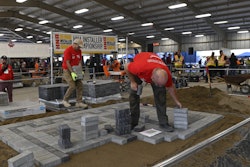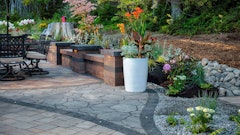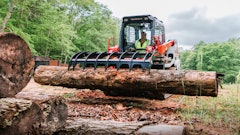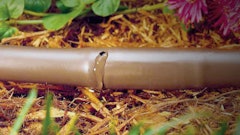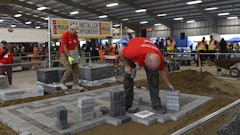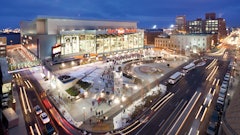
Whether it’s a pond, fountain or something else, water features have been bubbling up in popularity in recent years.
“As people become more disconnected from the natural world, we seek out experiences that illicit feelings of being in nature, says Joe Raboine, vice president of design at Oldcastle APG, parent company of Belgard Hardscapes and PebbleTec Pool Finishes. “Water, the foundation for life on earth, is one of the best ways to receive those benefits. There is something so soothing and calming about viewing water, hearing it and, in some cases, touching it through interactive installations.”
Here’s what landscape pros need to know about these trending features.
What’s hot
As with other hardscape features, experts are seeing more water features that are natural-like and participatory.
“Natural-like water features have and continue to be popular with folks looking to mimic nature,” says Kip Northrup, owner at Blue Thumb. “Participatory water features allow owners and guests to engage the water. Many times, natural-like and participatory water features are one in the same.”
Northrup cautions that installing natural-like water features can pose a challenge.
“Attempting to replicate Mother Nature is very difficult, but with training and practice, the installers can create beautiful artwork,” Northrup says. “(Installers) should also try new creative ideas and techniques when installing water features.”
In addition to natural-looking water features Raboine says there’s another trend on the other side of the spectrum that’s gained traction: formal water features.
“Both seek to achieve the same thing: to provide a visually appealing sensory experience that brings a sense of calm, comfort and peace to a landscape, both residentially and commercially,” Raboine says.
Many stand-alone features like bubbling urns, pots, etc., also continue to grow in popularity, Raboine says.
“Most of these do not sit in an open basin but instead flow into underground basins filled with stone or other media,” Raboine says. “They are incredibly easy to maintain and still offer all the benefits of formal or natural ponds/features.”
Taking it up a level, some water features even incorporate fire elements, says Kari Paulson, vice president of marketing with PebbleTec Pool Finishes.
“The addition of a fire element, sometimes in conjunction with the water feature, can bring extra ambiance and interest to an environment,” Paulson says.
Wes Hardwick, category manager for Irrigation and Lighting at SiteOne Landscape Supply, notes a few other water feature trends:
· High-end koi ponds have always been popular with higher end-clientele, but with the availability of advanced filtration and a greater awareness through social media, they are experiencing a renewal, Hardwick says.
· Rec ponds provide an alternative to traditional swimming pools that use chemicals to keep the water clean, and, Hardwick says, they also add a natural-looking element to a landscape.
· Water garden/pond rehabs have been influenced by demand. Many ponds have been built over the last several decades and can be improved by providing clearer and healthier water. Hardwick notes that more often than not, homeowners want an affordable, minimally intrusive solution to their pond issues.
· Fountain features continue to be a prevalent category due to their lower cost, ease of installation and ease of maintenance, Hardwick says.
“The North American approach to water gardening is evolving quickly, and the marketplace is understanding the advantages to incorporating advanced filtration on koi ponds and rec ponds,” Hardick says. “Continued awareness through social media coupled with training for the professionals will continue to reshape the industry.”
All in all, Raboine says there are more options than ever to create any style of water feature one desires.
“The challenge is to make sure they are properly built, but with so much information online, and many experts willing to help, I would say if you can dream it, it can be built,” Raboine says.
Top materials
Materials that mimic nature, such as stone and gravel, are often used in residential water features, but Raboine says more and more, concrete has been utilized to mimic natural water features.
On the other hand, formal water features may incorporate concrete or stone materials, tile and more, Raboine says.
“Typically, they are more linear or modular and can feature fountains, spillways or laminar jets. Oftentimes, these features double as built-in plunge pools or spas, and as the average yard continues to shrink, creating dual-purpose features is vital to maximize the space,” Raboine says.
Paulson says she’s even seen metals, like hammered copper and stainless steel, included in water features.
Northrup agrees.
“We are also seeing metal and acrylic fountains grow in popularity,” Northrup says. “Brass, copper, GFRC and acrylic fountains have become a staple of our water feature offerings.”
Installer tips
First and foremost, a water feature installer should be trained, Hardwick says.
“Like any task, experience and training are an important element to become a proficient installer,” Hardwick says. “Mistakes are limited when installing a fountain feature; however, you need to be properly trained prior to installing a high-end koi pond or rec pond.”
Installers also need to be able to appropriately size a water feature, which, Northrup says, comes with experience and training.
“Oftentimes people grow extremely fond of the water feature or pond and decide to enlarge it at a later date,” Northrup says. “As the hobby and participation with the water feature grows, so does the desire to modify and expand the water feature.”
On a similar note, Raboine suggests having a clear direction before beginning an installation.
“The most common mistake is understanding whether you want it to be natural or formal and then treating the water accordingly,” Raboine says. “If it’s a formal feature with a basin, you may want to treat it like a pool and consider keeping it sterile. If it’s natural with plants and animals, then you will want to design it to be in balance. Either type should have a future, and you should test to make sure the water is balanced to support your goal.”
Maintenance musts
As with all hobbies, caring for the equipment is key: Proper water treatment schedule and pump care are paramount.
“Most typically weekly or biweekly treatments are adequate for maintaining a beautiful water feature year-round,” Northrup says. “Water feature type and water feature material will affect this routine, but the hobbyist will find a routine that fits them and their water feature.”
Raboine says that water feature manufacturers and online forums can help installers figure out what that water balance should be.
Hardwick notes that rec ponds and koi ponds can be maintenance intensive with the absence of advanced filtration.
“Advanced pond filtration is used for high-end koi ponds, rec ponds and pond rehabs,” Hardwick says. “In some cases, the advanced filtration can have cloud-based controllability.”
Additionally, if a water feature is built into any kind of pool, Paulson recommends that a professional pool service be consulted to ensure optimally managed pool chemistry.
It’s also critical to keep features free of leaves and debris.
“Again, this depends on the type of feature, but most need to be kept from filling up, especially in the fall, or near trees and bushes that may lose leaves throughout the year,” Raboine says.
Looking ahead
Moving forward, Northrup says he expects to see features that are easy to install, care for and interact with.
“These reflect the materials such as copper, GFRC and acrylic—all of these materials continue to be a simple and clear option for water feature hobbyists looking for a unique and easy to care for water feature element,” Northrup says.
Overall, Raboine says he thinks water features will become more and more part of the landscape and outdoor living environments.
“Their ability to offer a visual focal point, attract wildlife, mask road and other external noises and provide a soothing feeling make them a natural choice to add,” Raboine says. “They will also more and more become opportunities to get creative and allow double as an art piece as well. Mixing natural materials with metal, glass and other materials will also continue to expand.”





